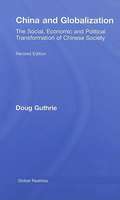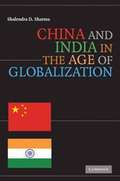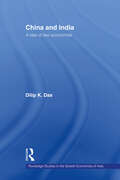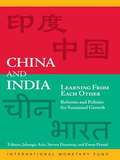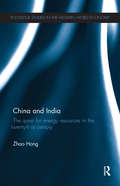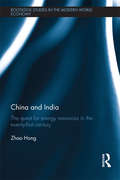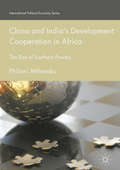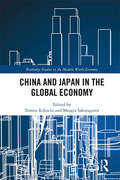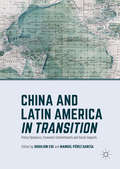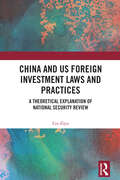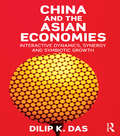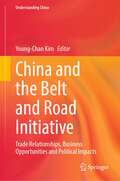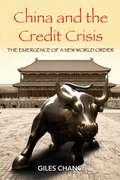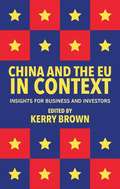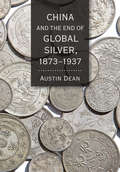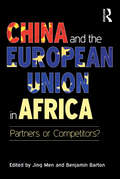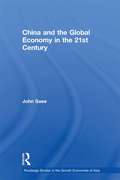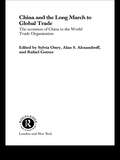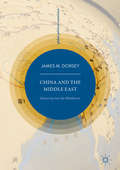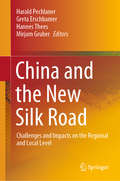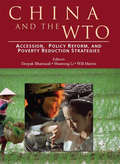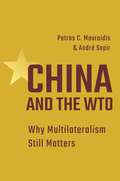- Table View
- List View
China and Globalization: The Social, Economic and Political Transformation of Chinese Society (revised edition)
by Doug GuthrieGuthrie (sociology and management, New York U.) argues that the changes in China have been more dramatic than outsiders especially in the US realize, that reforms have been successful because of state involvement, and that democracy in China is inevitable. He does not posit some occult connection between capitalism and democracy, but explains that the deliberate transformation of certain institutions has set in motion a gradual process of democratization that leaders know about but do not advertise. Annotation ©2008 Book News, Inc., Portland, OR (booknews.com)
China and India in the Age of Globalization
by Shalendra D. SharmaThe rise of China and India is the story of our times. The unprecedented expansion of their economic and power capabilities raises profound questions for scholars and policymakers. What forces propelled these two Asian giants into global pacesetters, and what does their emergence mean for the United States and the world? With intimate detail, Shalendra D. Sharma's China and India in the Age of Globalization explores how the interplay of socio-historical, political, and economic forces has transformed these once poor agrarian societies into economic powerhouses. Yet, globalization is hardly a seamless process, as the vagaries and uncertainties of globalization also present risks and challenges. This book examines the challenges both countries face and what each must do to strike the balance between reaping the opportunities and mitigating the risks. For the United States, assisting a rising China to become a responsible global stakeholder and fostering peace and stability in the volatile subcontinent will be paramount in the coming years.
China and India: A Tale of Two Economies (Routledge Studies in the Growth Economies of Asia #Vol. 66)
by Dilip K. DasThe economies of the People’s Republic of China and India are emerging-market economies, which account for more than a third of the global population. These two economies share many similarities in that they are large populous neighbours, who were regarded as abjectly poor countries until the 1980s and both are ancient cultures which has both advantages and disadvantages for economic development. However, their political systems are very different. While India is an open democratic society, China is a closed society run in an authoritarian manner by the Chinese Communist Party. This dissimilarity impacts on the economic decision making process in the two economies. This book is the first to systematically compare and contrast the two economies. It takes an objective and dispassionate view and delves into the constructive and favourable side as well as adverse and unfavourable side of the two economies. Written in a comprehensive and authoritative manner, it covers large areas of the two economies, including trade and financial sectors. It also includes other important relevant facets of the two economies.
China and India: Reforms and Policies for Sustained Growth
by Jahangir Aziz Steven Dunaway Eswar PrasadThis publication contains 13 papers presented at an international seminar, held in Beijing in October 2005, which was jointly organised by the IMF, the China Society for Finance and Banking, and the Stanford Center for International Development. The papers set out the analysis of high-level policymakers and advisors in China and India about the structural economic reforms being implemented in their respective countries, and the challenges and lessons to be learned from their experiences in order to achieve long-term sustainable development. The papers focus on the following issues: banking sector reform, securities market development, domestic financial liberalisation and international financial integration, fiscal dimensions of sustaining high growth, Sino-Indian economic co-operation, and the implications of the emergence of China and India for the regional and international financial system.
China and India: The Quest for Energy Resources in the 21st Century (Routledge Studies In The Modern World Economy Ser.)
by Hong ZhaoThe book sheds understanding on the relations between development and global energy security by looking at China and India. It addresses the following issues: what is the new definition of energy security? How does it affect global politics and international relations? What are the energy security concerns of China and India, and what policies and approaches have they taken to deal with energy security issues? Since China and India are searching for oil and gas in the Middle East, Africa, and Southeast Asia, would their acquisition efforts conflict with the interests of other energy giants such as the U.S., Japan, and would their growing overseas activities challenge U.S. policy in those energy-rich regions?The book provides insight into what the new global energy order may be and how the growth models and energy structures may shape the economic growth and energy. It analyzes both the state-centered approach and market-oriented approach in the global quest for energy resources. It also examines how China and India can adopt a cooperative approach for beneficial relations. The book will be of interest to anyone who is keen to learn how the World especially U.S.A. can accomodate and adapt to the new global energy dynamics and on China and India as new players in global energy markets.
China and India: The Quest for Energy Resources in the 21st Century (Routledge Studies In The Modern World Economy Ser.)
by Hong ZhaoThe book sheds understanding on the relations between development and global energy security by looking at China and India. It addresses the following issues: what is the new definition of energy security, how does it affect global politics and international relations? What are the energy security concerns of China and India, and what policies and approaches have they taken to deal with energy security issues? Since China and India are searching for oil and gas in the Middle East, Africa, and Southeast Asia, will their acquisition efforts conflict with the interests of other energy giants such as the U.S., Japan, and will their growing overseas activities challenge U.S. policy in those energy-rich regions? The book provides insight into what the new global energy order may be and how the growth models and energy structures may shape the economic growth and energy. It analyzes both the state-centered approach and market-oriented approach in the global quest for energy resources. It also examines how China and India can adopt a cooperative approach for beneficial relations. The book will be of interest to anyone who is keen to learn how the World especially U.S.A. can accomodate and adapt to the new global energy dynamics; China and India as new players in global energy markets.
China and India’s Development Cooperation in Africa: The Rise Of Southern Powers (International Political Economy Ser)
by Philani MthembuExplaining the determinants of China and India’s development cooperation in Africa cannot be achieved in simple terms. After collecting over 1000 development cooperation projects by China and India in Africa using AidData, this book applies the method of qualitative comparative analysis (QCA) to understand the motives behind their development cooperation. Mthembu posits that neither China nor India were solely motivated by one causal factor, whether strategic, economic or humanitarian interests or the size of their diaspora in Africa. China and India are driven by multiple and conjunctural factors in providing more development cooperation to some countries than others on the African continent. Only when some of these respective causal factors are combined is it evident that both countries disbursed high levels of development cooperation to some African countries.
China and Japan in the Global Economy (Routledge Studies in the Modern World Economy)
by Tomoo Kikuchi Masaya SakuragawaThis book discusses the necessity for cooperation between China and Japan to provide international public goods to Asia. It provides insight into how China and Japan can redesign the process of economic integration and security architecture to ensure peace and prosperity in Asia, and how China and Japan can cooperate to correct the capital misallocation and channel savings more effectively to investments in Asia. It also suggests how China and Japan can promote free trade to help Asian economies upgrade their industries in the global supply chain. The book is an invaluable contribution to the existing discussion on China–Japan relations and how their cooperation is beneficial not only for them but also for Asia, and even the world.
China and Latin America in Transition: Policy Dynamics, Economic Commitments, and Social Impacts
by Shoujun Cui Manuel Pérez GarcíaThis volume explores the policy dynamics, economic commitments and social impacts of the fast evolving Sino-LAC relations. China's engagement with Latin America and the Caribbean has entered into an era of strategic transition. While China is committed to strengthening its economic and political ties with Latin America and the Caribbean, Latin America as a bloc is enthusiastically echoing China's endeavor by diverting their focus toward the other side of the ocean. The transitional aspect of China-LAC ties is phenomenal, and is manifested not only in the accelerating momentum of trade, investment, and loan but also in the China-CELAC Forum mechanism that maps out an institutional framework for decades beyond. While Latin America is redefined as an emerging priority to the leadership in Beijing, what are the responses from Latin America and the United States? In this sense, experts from four continents provide local answers to this global question.
China and US Foreign Investment Laws and Practices: A Theoretical Explanation of National Security Review
by Liu ZiyuThe book is a comparative study of the national security review of foreign investment laws in China and the US.The author establishes a theoretical framework to explain the dominant role of ideas on national security and foreign investment rooted in China and the US, as well as the oriented role of China-US investment interaction. She concludes that it is difficult for China and the US to reach a consensus on national security review due to their different internal ideas on national security and foreign investment. By comparing the similarities and differences in the development of national security review in China and the US, she also proposes a feasible approach to facilitate bilateral investment practices.The book will attract scholars of international economic law, investment law, and Sino-US relations.
China and the Asian Economies: Interactive Dynamics, Synergy and Symbiotic Growth
by Dilip K. DasThe global economy is currently going through a period of transformation that has seen Asia emerge as the most rapidly growing, industrializing and modernizing region in the world economy. Whilst the rest of the world struggled during the financial crisis of 2007-9, Asia played the role of a linchpin for global economic recovery. This book analyzes the growth of key Asian economies in the latter half of the twentieth century, followed a little later by China. Notwithstanding the diversity in the region, rapid growth was instrumental in integrating the Asian economies initially in a market-led manner. Dilip K. Das focuses on the interactive dynamics and the process of integration in the region, exploring the synergy created as well as the resulting symbiotic growth among the Asian economies and China. Written in a clear, comprehensive and critical manner by a world class expert in the field, this book brings together the contemporary academic and policy debates on the issues under examination. As such it is an essential read for students and scholars of economics, international political economy and Asian Studies as well as MBA students.
China and the Belt and Road Initiative: Trade Relationships, Business Opportunities and Political Impacts (Understanding China)
by Young-Chan KimThis book offers critical insights into the China-led Belt and Road Initiative (BRI) from an EU perspective. It analyzes the political, cultural, and diplomatic effectiveness of Xi's efforts to expand socio-cultural ties and build new trade corridors between Europe and the Far East, and sheds light on the lasting success and influence of China-led economic programs.The book is divided into three parts. The first part provides an overview of the various dimensions of the BRI initiative, including the challenges and opportunities of the EU-China trade relationship, China's geopolitical interests, and foreign policy approaches. The second part analyzes BRI cooperation from the perspective of the business sector, while the third part presents case studies that examine the impacts and responses of various European countries to the BRI.
China and the Credit Crisis
by Giles ChanceThe western world attributed China's role as world's largest financer of the developed world and third largest economy in the world to new economic efficiencies, a revolution in risk management and its own wise policies. China and the Credit Crisis argues that if the extent of the role played in the new prosperity by an emerging China, and the fundamental nature of the changes it brought had been better understood, more appropriate policies and actions would have been adopted at the time which could have avoided the crash, or at least limited its impact. China's Credit Crisis examines the larger role that China will play in the recovery from the current credit crisis and in the post-crisis world. It addresses the major questions which arise from the financial crisis and discuss the landscape of the post-credit crisis world, initially by continuing to provide growth to a world deep in recession, and later by sharing global economic and political leadership
China and the EU in Context
by Kerry BrownChina and the EU in Context brings together the research of world-class commentators on China from across Europe to explore the economic, political, investment, and trade relations between China and the EU. Brown provides a comprehensive overview to explain the key challenges currently facing those who are seeking to work with the Chinese or in China. Written for senior executives and investors, this accessible book shows how to relate to China practically and understand the internal dynamics for business purposes, exploring themes including investment, social unrest, and China's five-year program.
China and the End of Global Silver, 1873–1937 (Cornell Studies in Money)
by Austin DeanIn the late nineteenth century, as much of the world adopted some variant of the gold standard, China remained the most populous country still using silver. Yet China had no unified national currency; there was not one monetary standard but many. Silver coins circulated alongside chunks of silver and every transaction became an "encounter of wits." China and the End of Global Silver, 1873–1937 focuses on how officials, policy makers, bankers, merchants, academics, and journalists in China and around the world answered a simple question: how should China change its monetary system? Far from a narrow, technical issue, Chinese monetary reform is a dramatic story full of political revolutions, economic depressions, chance, and contingency. As different governments in China attempted to create a unified monetary standard in the late nineteenth and early twentieth century, the United States, England, and Japan tried to shape the direction of Chinese monetary reform for their own benefit. Austin Dean argues convincingly that the Silver Era in world history ended owing to the interaction of imperial competition in East Asia and the state-building projects of different governments in China. When the Nationalist government of China went off the silver standard in 1935, it marked a key moment not just in Chinese history but in world history.
China and the European Union in Africa: Partners or Competitors? (Routledge Studies In African Politics And International Relations Ser.)
by Benjamin BartonChina's rise on the international scene over the past few years has correlated with its exponential economic growth. The European Union (EU), the world's largest development aid provider, has been feeling the heat of Beijing's closer ties with Africa. As a result, the EU's overall policy-making towards Africa has suffered from a loss of credibility and this has been further exposed both by the success of China's investments in Africa, and by the favourable response that China's investment proposals have received from African leaders. Dividing the book into five parts, the editors and an outstanding line up of Chinese and European contributors guide the reader through the complexities of China's rising influence in Africa, but they also analyse if and how the EU should adapt to this. "
China and the Global Economy in the 21st Century (Routledge Studies in the Growth Economies of Asia)
by John SaeeAs China continues to ride out the global economic crisis while still retaining year on year GDP growth it is increasingly important to understand how this 'new' economic giant, with its communist-capitalist model operates its economic and business environments. This book is designed to scientifically examine the contextual variables that foster sustainably dynamic economic growth in China. In particular, the contributors provide an incisive analysis of the contextual bases underlying such a dramatic rising economic power and the immense implications for enterprises and countries involved in dealing with China. Drawing on the latest studies and cutting edge research findings, this book analyses FDI, project management, internationalisation, the continued role of state-owned enterprises and doing business in China. As such it will be essential reading for all students of Chinese business and economics, as well as businesses seeking to develop a critical understanding of the driving global economic force which is China.
China and the Long March to Global Trade: The Accession of China to the World Trade Organization (Routledge Studies In The Growth Economies Of Asia Ser.)
by Rafael Gomez Sylvia Ostry Alan S. AlexandroffOn December 11th 2001, China joined the World Trade Organization (WTO). China and the Long March to Global Trade examines the prolonged negotiations leading up to this historic event. This edited collection assumes little prior knowledge of the Chinese accession process yet provides an in-depth examination of the related issues. It is therefore sui
China and the Middle East: Venturing into the Maelstrom (Global Political Transitions)
by James M. DorseyThis book explores China’s significant economic and security interests in the Middle East and South Asia. To protect its economic and security interests, China is increasingly forced to compromise its long-held foreign policy and defence principles, which include insistence on non-interference in the domestic affairs of others, refusal to envision a foreign military presence, and focus on the development of mutually beneficial economic and commercial relations. The volume shows that China’s need to redefine requirements for the safeguarding of its national interests positioned the country as a regional player in competitive cooperation with the United States and the dominant external actor in the region. The project would be ideal for scholarly audiences interested in Regional Politics, China, South Asia, the Middle East, and economic and security studies.
China and the New Silk Road: Challenges and Impacts on the Regional and Local Level
by Harald Pechlaner Greta Erschbamer Hannes Thees Mirjam GruberThis book studies the Chinese “Belt and Road Initiative” (BRI), also called "New Silk Road", and focuses on its regional and local effects. Written by experts from various fields, it presents a range of case studies on the geopolitical, socio-economic, ecological and cultural implications of the BRI for European regions and their stakeholders. The book is divided into four parts, the first of which discusses the history of and China’s motivations for the BRI. The second part explores the global phenomenon from a number of regional standpoints. In turn, the third part presents studies on the political, socio-economic, cultural and ecological implications of the New Silk Road project. The final part highlights the tourism prospects in connection with the Silk Road project, as tourism has established itself as an important economic sector in many regions along the historic Silk Road. This book will appeal to scholars of economics, international relations and tourism, decision-makers, managers, chambers of commerce and entrepreneurs with special interests in establishing collaboration with the Chinese market.
China and the WTO: Accession, Policy Reform, and Poverty Reduction Strategies
by William J. Martin Shantong Li Deepak BhattasaliChina's accession to the WTO requires a great many specific policy reforms. However, if the best results are to be obtained, it is important that these reforms be implemented as part of a consistent development program, rather than simply by treating them as a recipe. To do this, policy makers must understand the range and nature of the policy changes required by accession, their implications for the economy, and the availability and effects of supporting policies. 'China and the WTO' analyzes the nature of the reforms involved in China's accession to the WTO, assesses their implications for the world economy, and examines the implications for individual households, particularly the poor. Its key objective is to provide the information that will allow policy makers to implement WTO commitments and formulate supporting policies to contribute strongly to economic development and poverty reduction. Individual chapters by leading scholars analyze the nature of the reforms in key areas, such as agriculture, services, intellectual property and safeguards and anti-dumping. These chapters form the building blocks for later chapters which analyze the implications of reform for the economy. The book also includes a series of studies that assess the implications for households, taking into account the social safety net policies applying in China, and the impacts of complementary policies in areas such as labor market reform and investments in human capital. Of interest to policymakers, academe and students studying international trade issues and to practitioners in the area of trade and development, 'China and the WTO' is a valuable addition to the wealth of information provided by the World Bank Trade and Development Series.
China and the WTO: Doing the Right Thing?
by Regina AbramiIn late 2001, the People's Republic of China joined the World Trade Organization (WTO). Sets the terms of China's accession agreement against its compliance record some two years later. Discusses why key actors, such as business, organized labor, and other governments, either favored or opposed China's entry into the WTO. In addition, provides historical background on Chinese foreign economic relations, especially trade relations with the United States. Also covers recent changes in China's domestic political economy, including discussion of its new political leadership.
China and the WTO: What Price Membership?
by Richard H.K. Vietor Julia GalefChina has been a member of the WTO for more than five years. Its implementation of requirements has been a mixed bag. While China's growth is still spectacular, many institutional problems remain. And there is a new problem--a spectacular trade asymmetry with the United States.
China and the WTO: Why Multilateralism Still Matters
by Petros C. Mavroidis Professor Andre SapirAn examination of China’s participation in the World Trade Organization, the conflicts it has caused, and how WTO reforms could ease them China’s accession to the World Trade Organization (WTO) in 2001 was rightly hailed as a huge step forward in international cooperation. However, China’s participation in the WTO has been anything but smooth, with China alienating some of its trading partners, particularly the United States. The mismatch between the WTO framework and China’s economic model has undermined the WTO’s ability to mitigate tensions arising from China’s size and rapid growth. What has to change? China and the WTO demonstrates that unilateral pressure, by the United States and others, is not the answer. Instead, Petros Mavroidis and André Sapir show that if the WTO enacts judicious reforms, it could induce China’s cooperation, leading to a renewed confidence in the WTO system.The WTO and its predecessor, the General Agreement on Tariffs and Trade, are predicated on liberal domestic policies. They managed the previous accessions of socialist countries and big trading nations, but none were as large or powerful as China. Mavroidis and Sapir contend that for the WTO to function smoothly and accommodate China’s unique geopolitical position, it needs to translate some of its implicit principles into explicit treaty language. To make their point, they focus on two core complaints—that Chinese state-owned enterprises (SOEs) benefit from unfair trade advantages, and that domestic companies, private as well as SOEs, impose forced technology transfer on foreign companies as a condition for accessing the Chinese market—and they lay out specific proposals for WTO reforms.In an age of global trade disputes, China and the WTO offers a timely exploration of unprecedented challenges to the current multilateral system and fresh ideas for lasting solutions.
China and the World Economy
by David Greenaway Chris Milner Shujie YaoThe rising importance of China and its impact on the world economy has attracted massive interest worldwide. This book examines a wide range of issues related to China and its relationship with the world economy, focusing on its successful development experiences and how its rise may affect the rest of the world in the coming decades.
